Physics: Marie Curie
Summary of Madame Marie Curie's contribution to Science.
Biography, Quotes, Photographs
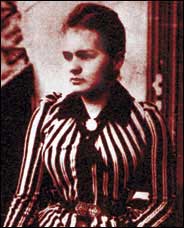 I divided my time between courses, experimental work, and study in the library. In the evening I worked in my room, sometimes very late into the night. All that I saw and learned that was new delighted me. It was like a new world opened to me, the world of science, which I was at last permitted to know in all liberty.
... During these years of isolated work, trying little by little to find my real preferences, I finally turned towards mathematics and physics, and resolutely undertook a serious preparation for future work.
I divided my time between courses, experimental work, and study in the library. In the evening I worked in my room, sometimes very late into the night. All that I saw and learned that was new delighted me. It was like a new world opened to me, the world of science, which I was at last permitted to know in all liberty.
... During these years of isolated work, trying little by little to find my real preferences, I finally turned towards mathematics and physics, and resolutely undertook a serious preparation for future work.
(Marie Curie, who travelled from Warsaw to Paris to study in 1891)
I noticed the grave and gentle expression of his face, as well as a certain abandon in his attitude, suggesting the dreamer absorbed in his reflections.
(Marie Curie, on meeting Pierre Curie)
Biography of Madame Marie Curie
First Woman to win Noble Prize: Physics (1903) & Chemistry (1911)
On the Discovery of Radium & Polonium.
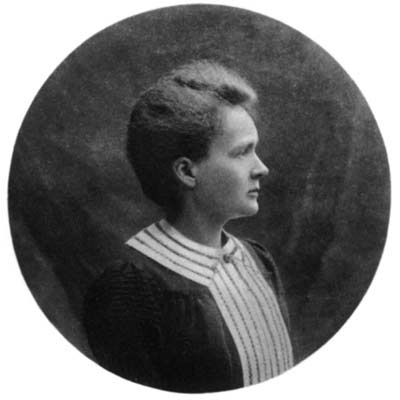 Marie Curie (1867 - 1934) was a Polish-born French chemist and pioneer in the early field of radiology and a two-time Nobel laureate. She founded the Curie Institutes in Paris and in Warsaw.
Marie Curie (1867 - 1934) was a Polish-born French chemist and pioneer in the early field of radiology and a two-time Nobel laureate. She founded the Curie Institutes in Paris and in Warsaw.
Her first years were sorrowful ones, marked by the death of her sister and, four years later, her mother. She was notable for her diligent work ethic, neglecting even food and sleep to study. Due to her gender, she was not allowed admission into any Russian or Polish universities so she worked as a governess for several years. Eventually, with the monetary assistance of her elder sister, she moved to Paris and studied chemistry and physics at the Sorbonne, where she became the first woman to teach.
Marie Curie's work in physics won her a scholarship. And a group of industrialists, the Society for the Encouragement of National Industry, paid her to investigate the magnetic properties of different steels. To carry out the work she needed a lab. She was introduced to Pierre Curie in spring 1894, who let Marie work in his laboratory. Pierre Curie had made important scientific discoveries on magnetism and crystals. As the relationship between Pierre and Marie deepened, he convinced her that she should pursue science in Paris, not return to Poland for good. She in turn convinced him to write up his magnetism research and get a doctoral degree. He was then promoted to a professorship.
Pierre and Marie married in July 1895. Over the next two years, Marie completed her research on the magnetic properties of steels. She submitted her final results shortly before giving birth to their first daughter, Irène, in September 1897. Pierre’s father, a retired doctor, moved in with them and helped raise Irène. Marie began looking for a research topic that would earn her a doctorate in science. No woman in the world had yet completed that degree.
Together they studied radioactive materials, particularly the uranium ore pitchblende, which had the curious property of being more radioactive than the uranium extracted from it. By 1898 they deduced a logical explanation: that the pitchblende contained traces of some unknown radioactive component which was far more radioactive than uranium; thus on December 26th Marie Curie announced the existence of this new substance. As Marie Curie wrote;
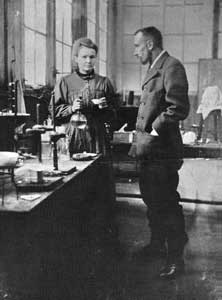 My experiments proved that the radiation of uranium compounds can be measured with precision under determined conditions, and that this radiation is an atomic property of the element of uranium. Its intensity is proportional to the quantity of uranium contained in the compound, and depends neither on conditions of chemical combination, nor on external circumstances, such as light or temperature.
My experiments proved that the radiation of uranium compounds can be measured with precision under determined conditions, and that this radiation is an atomic property of the element of uranium. Its intensity is proportional to the quantity of uranium contained in the compound, and depends neither on conditions of chemical combination, nor on external circumstances, such as light or temperature.
I undertook next to discover if there were other elements possessing the same property, and with this aim I examined all the elements then known, either in their pure state or in compounds. I found that among these bodies, thorium compounds are the only ones which emit rays similar to those of uranium.
During the course of my research, I had had occasion to examine not only simple compounds, salts and oxides, but also a great number of minerals. Certain ones proved radioactive; these were those containing uranium and thorium; but their radioactivity seemed abnormal, for it was much greater than the amount I had found in uranium and thorium had led me to expect.
This abnormality greatly surprised us. When I had assured myself that it was not due to an error in the experiment, it became necessary to find an explanation. I then made the hypothesis that the ores uranium and thorium contain in small quantity a substance much more strongly radioactive than either uranium or thorium. This substance could not be one of the known elements, because these had already been examined; it must, therefore, be a new chemical element.
I had a passionate desire to verify this hypothesis as rapidly as possible. And Pierre Curie, keenly interested in the question, abandoned his work on crystals (provisionally, he thought) to join me in the search for this unknown substance.
We chose, for our work, the ore pitchblende, a uranium ore, which in its pure state is about four times more active than oxide of uranium. Since the composition of this ore was known through very careful chemical analysis, we could expect to find, at a maximum, 1 per cent of new substance. The result of our experiment proved that there were in reality new radioactive elements in pitchblende, but that their proportion did not reach even a millionth per cent! (Marie Curie, from Pierre Curie pp. 96-98)
Over several years of unceasing labour they refined several tons of pitchblende, progressively concentrating the radioactive components, and eventually isolated initially the chloride salts (refining radium chloride on 20 April 1902) and then two new chemical elements. The first they named polonium after Marie's native country, and the other was named radium from its intense radioactivity. Other scientists did not trust the announcement, for the Curies did not have enough polonium and radium to see and weigh. The elements’ existence was known from nothing but their radioactivity. The Curies would have to separate their elements from the other substances they were mixed with. The storeroom at Pierre’s school was too small for such work, and the Curies continued their work in an abandoned shed nearby.
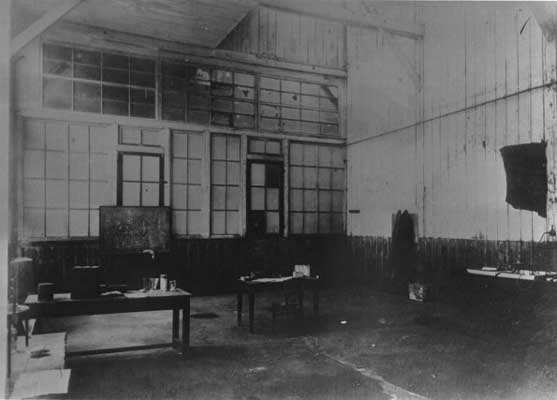
The School of Physics could give us no suitable premises, but for lack of anything better, the Director permitted us to use an abandoned shed which had been in service as a dissecting room of the School of Medicine. Its glass roof did not afford complete shelter against rain; the heat was suffocating in summer, and the bitter cold of winter was only a little lessened by the iron stove, except in its immediate vicinity. There was no question of obtaining the needed proper apparatus in common use by chemists. We simply had some old pine-wood tables with furnaces and gas burners. We had to use the adjoining yard for those of our chemical operations that involved producing irritating gases; even then the gas often filled our shed. With this equipment we entered on our exhausting work.
Yet it was in this miserable old shed that we passed the best and happiest years of our life, devoting our entire days to our work. Often I had to prepare our lunch in the shed, so as not to interrupt some particularly important operation. Sometimes I had to spend a whole day mixing a boiling mass with a heavy iron rod nearly as large as myself. I would be broken with fatigue at the day’s end. Other days, on the contrary, the work would be a most minute and delicate fractional crystallization, in the effort to concentrate the radium. I was then annoyed by the floating dust of iron and coal from which I could not protect my precious products. But I shall never be able to express the joy of the untroubled quietness of this atmosphere of research and the excitement of actual progress with the confident hope of still better results. The feeling of discouragement that sometimes came after some unsuccessful toil did not last long and gave way to renewed activity. We had happy moments devoted to a quiet discussion of our work, walking around our shed.
One of our joys was to go into our workroom at night; we then perceived on all sides the feebly luminous silhouettes of the bottles or capsules containing our products. It was really a lovely sight and one always new to us. The glowing tubes looked like faint, fairy lights. (Marie Curie, Autobiographical Notes pp. 186-187)
Industrial firms soon saw an opportunity and then helped the Curies by providing additional lab space, raw materials, and support staff. A thriving industry grew up, extracting radioactive substances for medical uses. As Madame Curie wrote;
It may be easily understood how deeply I appreciated the privilege of realizing that our discovery had become a benefit to mankind, not only through its great scientific importance, but also by its power of efficient action against human suffering and terrible disease. This was indeed a splendid reward for our years of hard toil. (Marie Curie, Autobiographical Notes pp. 199-200)
Radium was also used by scientists for experiments on atoms. They confirmed what Marie had suspected - the powerful energy that showed up in radioactivity was a fundamental property of every atom of matter.
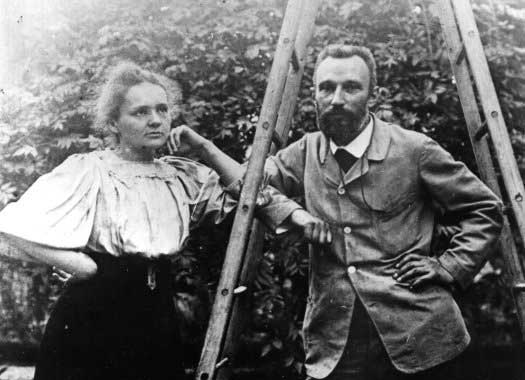 With Pierre Curie and Henri Becquerel, Marie was awarded the Nobel Prize in Physics, 1903: "in recognition of the extraordinary services they have rendered by their joint researches on the radiation phenomena discovered by Professor Henri Becquerel". She was the first woman to be awarded a Nobel Prize.
With Pierre Curie and Henri Becquerel, Marie was awarded the Nobel Prize in Physics, 1903: "in recognition of the extraordinary services they have rendered by their joint researches on the radiation phenomena discovered by Professor Henri Becquerel". She was the first woman to be awarded a Nobel Prize.
The Curie's newfound fame with the Nobel Prize was difficult for them both to bear at times. As writes Pierre Curie;
As you have seen, fortune favors us at this moment; but these favors of fortune do not come without many worries. We have never been less tranquil than at this moment. There are days when we scarcely have time to breathe. And to think that we dreamed of living in the wild, quite removed from human beings! (20 March 1902, A Letter from Pierre Curie to his friend E. Gouy)
In 1906, after working in the laboratory in the morning, Pierre Curie was on his way to a library when he slipped on the wet street and fell in front of a heavy horse-drawn wagon. It ran over his head, killing him instantly. Madame Curie reflects;
The death of my husband, coming immediately after the general knowledge of the discoveries with which his name is associated, was felt by the public, and especially by the scientific circles, to be a national misfortune. It was largely under the influence of this emotion that the Faculty of Sciences of Paris decided to offer me the chair, as professor, which my husband had occupied only one year and a half in the Sorbonne. It was an exceptional decision, as up to then no woman had held such a position. ... The honor that now came to me was deeply painful under the cruel circumstances of its coming. (Marie Curie)
Marie Curie decided to establish a scientific institution worthy of Pierre’s memory. Helped by her scientist friends, she persuaded the French government and the private Pasteur Foundation to fund a Radium Institute. Marie would head a radioactivity laboratory, and an eminent physician would lead its medical research laboratory.
Marie Curie received her second Nobel Prize in Chemistry, 1911 "in recognition of her services to the advancement of chemistry by the discovery of the elements radium and polonium, by the isolation of radium and the study of the nature and compounds of this remarkable element". In an unusual move, Curie intentionally did not patent the radium isolation process, instead leaving it open so the scientific community could research unhindered. She was the first person to win or share two Nobel Prizes.
In August 1914, Germany invaded France. Nearly all of Curie’s staff at the Radium Institute enlisted in the war effort. Scientific research had to halt during the World War, and Curie looked for ways her science could help. She pushed for the use of mobile radiography units for the treatment of wounded soldiers. These units were powered using tubes of radium emanation, a colorless, radioactive gas given off by radium, later to be identified as radon. Marie personally provided the tubes, milked from the radium she purified. Promptly after the war started, she cashed in her and her husband's gold Nobel Prize Medals for the war effort. As Marie Curie writes during the war;
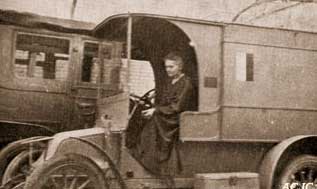 The dominant duty imposed on everyone at that time was to help the country in whatever way possible during the extreme crisis that it faced. No general instructions to this were given to the members of the University. It was left to each to take his own initiative and means of action.
The dominant duty imposed on everyone at that time was to help the country in whatever way possible during the extreme crisis that it faced. No general instructions to this were given to the members of the University. It was left to each to take his own initiative and means of action.
During the rapid succession of events in August 1914, it was clearly proved that the preparation for defence was insufficient. Public feeling was especially aroused by the realization of the grave failings which appeared in the organization of the Health Service. My own attention was particularly drawn to this situation, and I soon found a field of activity which, once entered upon, absorbed the greatest part of my time and efforts until the end of the war, and even for some time thereafter.
It is well known that the X-rays offer surgeons and doctors extremely useful means for the examination of the sick and wounded. However, at the beginning of the war, the Military Board of Health had no organization of radiology, while the civil organization was also but little developed. Radiologic installations existed in only a small number of important hospitals, and there were only a few specialists in the large cities. The numerous new hospitals that were established all over France in the first months of the war had, as a rule, no installation for the use of X-rays.
To meet this need I first gathered together all the apparatus I could find in the laboratories and stores. With this equipment I established in August and September, 1914, several stations of radiology, the operation of which was assured by volunteer helpers to whom I gave instruction. These stations rendered great service during the battle of the Marne. But as they could not satisfy the needs of all the hospitals of the Paris region, I fitted up, with the help of the Red Cross, a radiologic car. It was simply a touring motor-car, arranged for the transport of a complete radiologic apparatus, together with a dynamo that was worked by the engine of the car, and furnished the electric current necessary for the production of the rays. This car could come at the call of any of the hospitals, large or small, in the surroundings of Paris. Cases of urgent need were frequent, for these hospitals had to take care of the wounded who could not be transported to more distant places. (Marie Curie)
(Marie Curie, Pierre Curie with Autobiographical Notes. Translated by Charlotte and Vernon Kellogg (New York: Macmillan, 1923) pp. 208-211)
Radiology in War
The story of radiology in war offers a striking example of the unsuspected amplitude that the application of purely scientific discoveries can take under certain conditions.
X rays had had only a limited usefulness up to the time of the war. The great catastrophe which was let loose upon humanity, accumulating its victims in terrifying numbers, brought up by reaction the ardent desire to save everything that could be saved and to exploit every means of sparing and protecting human life.
At once there appeared an effort to make the X ray yield its maximum of service. What had seemed difficult became easy and received an immediate solution. The material and the personnel were multiplied as if by enchantment. All those who did not understand gave in or accepted; those who did not know learned; those who had been indifferent became devoted. Thus the scientific discovery achieved the conquest of its natural field of action. A similar evolution took place in radiumtherapy, or the medical application of radiations emitted by the radio elements.
What are we to conclude from this unhoped for development shared between the new radiations revealed to us by science at the end of the nineteenth century? It seems that they must make our confidence in disinterested research more alive and increase our reverence and admiration for it. (Marie Curie)
(Madame Curie. Translated by Vincent Sheean (Garden City, NY: Doubleday, Doran, 1938), © Doubleday, Doran. p. 306.)
In 1921, Marie Curie toured the United States, where she was welcomed triumphantly, to raise funds for research on radium.
She returned with a gram of radium - only a speck, but so fiercely radioactive that it could fuel thousands of experiments - as well as expensive equipment and cash for the Radium Institute.
In her later years, she was disappointed by the myriad of physicians and makers of cosmetics who used radioactive material without precautions. Her death near Sallanches, France in 1934 was from aplastic pernicious anemia, almost certainly due to her massive exposure to radiation in her work. Her elder daughter, Irène Joliot-Curie, won a Nobel Prize for Chemistry in 1935, the year after Marie Curie's death. Her younger daughter, Eve Curie, wrote her biography Madame Curie after her death.
Based upon:
https://www.aip.org/history/curie/
https://en.wikipedia.org/wiki/Marie_Curie
Help Humanity
"You must be the change you wish to see in the world."
(Mohandas Gandhi)
 "When forced to summarize the general theory of relativity in one sentence:
Time and space and gravitation have no separate existence from matter. ... Physical objects are not in space, but these objects are spatially extended. In this way the concept 'empty space' loses its meaning. ... The particle can only appear as a limited region in space in which
the field strength or the energy density are particularly high. ...
"When forced to summarize the general theory of relativity in one sentence:
Time and space and gravitation have no separate existence from matter. ... Physical objects are not in space, but these objects are spatially extended. In this way the concept 'empty space' loses its meaning. ... The particle can only appear as a limited region in space in which
the field strength or the energy density are particularly high. ...
The free, unhampered exchange of ideas and scientific conclusions is necessary for the sound development of science, as it is in all spheres
of cultural life. ... We must not conceal from ourselves that no improvement in the present depressing situation is possible without
a severe struggle; for the handful of those who are really determined to do something is minute in comparison with the mass of the lukewarm
and the misguided. ...
Humanity is going to need a substantially new way of thinking if it is to survive!" (Albert Einstein)
 Our world is in great trouble due to human behaviour founded on myths and customs that are causing the destruction of Nature and climate change. We can now deduce the most simple science theory of reality - the wave structure of matter in space. By understanding how we and everything around us are interconnected
in Space we can then deduce solutions to the fundamental problems of human knowledge in physics, philosophy, metaphysics, theology, education, health, evolution and ecology, politics and society.
Our world is in great trouble due to human behaviour founded on myths and customs that are causing the destruction of Nature and climate change. We can now deduce the most simple science theory of reality - the wave structure of matter in space. By understanding how we and everything around us are interconnected
in Space we can then deduce solutions to the fundamental problems of human knowledge in physics, philosophy, metaphysics, theology, education, health, evolution and ecology, politics and society.
This is the profound new way of thinking that Einstein
realised, that we exist as spatially extended structures of the universe - the discrete and separate body an illusion. This simply confirms the
intuitions of the ancient philosophers and mystics.
Given the current censorship in physics / philosophy of science journals (based on the standard model of particle physics / big bang cosmology) the internet is the best hope for getting new knowledge
known to the world. But that depends on you, the people who care about science and society, realise the importance of truth and reality.
It is Easy to Help!
Just click on the Social Network links below, or copy a nice image or quote you like and share it. We have a wonderful collection of knowledge from the greatest minds in human history, so people will appreciate your contributions. In doing this you will help a new generation of scientists see that there is a simple sensible explanation of physical reality - the source of truth and wisdom, the only cure for the madness of man! Thanks! Geoff Haselhurst (Updated September, 2018)
A new scientific truth does not triumph by convincing its opponents and making them see the light, but rather because its opponents eventually die, and a new generation grows up that is familiar with it. (Max Planck, 1920)
| Tweet Follow @philosophytruth | |
| Geoff | |
Connect with Geoff Haselhurst at Facebook
"All that is necessary for evil to succeed is for good people to do nothing."
(Edmund Burke)
"In a time of universal deceit - telling the truth is a revolutionary act."
(George Orwell)
"Hell is Truth Seen Too Late."
(Thomas Hobbes)
Legal Disclaimer and Privacy Policy












